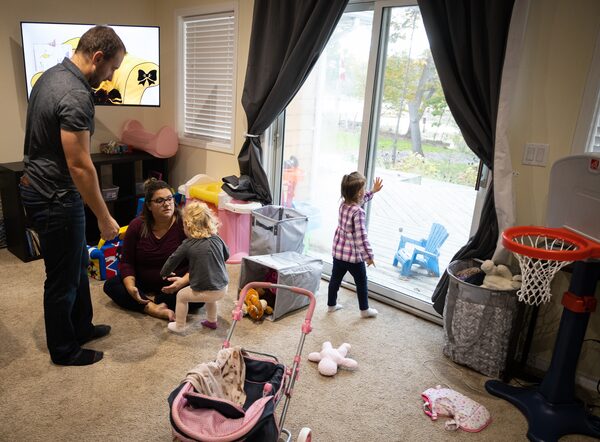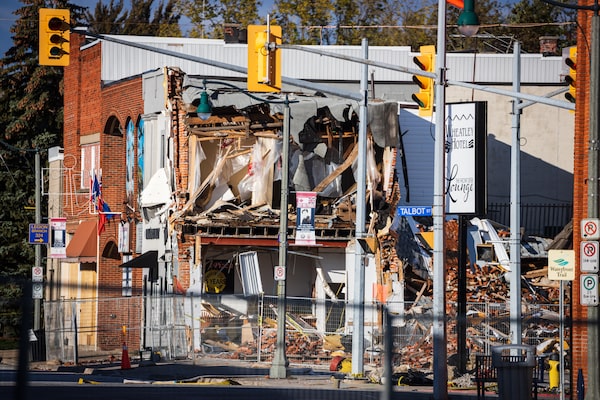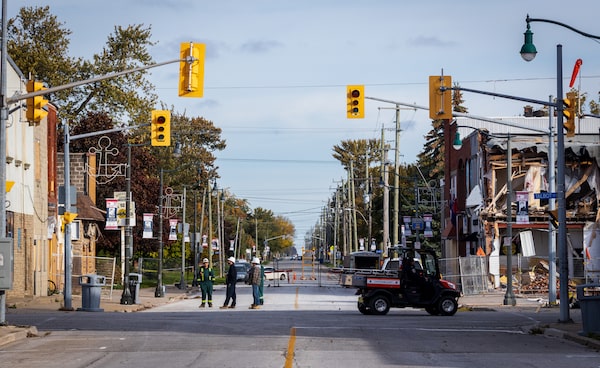
Jeremy and Stephanie Charbonneau with their daughters Elaine and Maybel at their current rental in Wheatley, Ont., on Oct. 26.Melissa Tait/The Globe and Mail
It has been more than two months since two-year-old Elaine Charbonneau was awakened by a loud boom five doors down from her home in Wheatley, Ont. She still doesn’t sleep through the night. And her family doesn’t know when – or if – they’ll be allowed back into their home.
The Aug. 26 explosion that rocked the small Southwestern Ontario town flattened two buildings, badly damaged several more, injured 20 people and forced about 100 people from their homes.
Last week, an investigation led by the province, in co-operation with the Municipality of Chatham-Kent, confirmed that an old natural gas well located close to the blast site is the source of several flammable hydrogen sulphide leaks. More analysis needs to be done to determine whether it was the cause of the explosion.
It’s one of a handful of wells around the town, and among 27,000 scattered across the province, mostly in the southwest. Most are no longer used and some are now leaking, having never been plugged properly. The Ontario Petroleum Institute, which represents the oil and gas extraction industry, estimates 4,400 of those sites are dangerous and pose a risk to communities.
Investigation underway into explosion that rocked small Ontario town of Wheatley
The August blast followed two major gas leaks in downtown Wheatley earlier in the summer, both of which were serious enough for Chatham-Kent Mayor Darrin Canniff to declare a state of emergency and for the fire department to evacuate residents and businesses for days at a time. Fire crews were in the midst of evacuating residents downwind from the poisonous gas for a third time when the explosion occurred.
Ontario Premier Doug Ford visited Wheatley not long after the incident, pledging $2-million to support the community.
While the investigation hasn’t yet pinpointed the exact cause of the explosion, Chatham-Kent chief administrative officer Don Shropshire told The Globe and Mail in a recent interview that confirmation of a well leak near the site is a step forward.
And, now that a gas well is involved, he said he expects that the municipality will be able to access Ontario’s abandoned-works program, which funds the cleanup of old oil and gas infrastructure.
“The fact that they’ve actually identified an abandoned gas well, now their legislation kicks in and they can actually take some more tangible steps to say, ‘Right, here’s what we need to do to deal with this,’ ” Mr. Shropshire said.

The centre of Wheatley, Ont., has been blocked for two months after an explosion injured 20 people, destroyed two buildings and badly damaged dozens of others.Melissa Tait/The Globe and Mail
A public meeting for Wheatley is slated for Wednesday and Mr. Shropshire hopes by then the municipality will have more information to share with the town’s 3,200 residents. He said a plan to deal with the fallout of the explosion could be in place this week, but that it will take longer to arrive at a concrete timeline of next steps.
Downtown Wheatley remains closed to people and vehicles, with tall metal fencing and police tape blocking off the heart of the community. The local bank, restaurants, pharmacy, library, hair salon, dentist, law offices, gas station and other businesses all remain shuttered.
“Wheatley strong” signs stud lawns in the community and surrounding towns, a show of support from residents who have rallied around evacuees with donations of food, furniture, toys, clothing and money.
Community organizer Kimberley Grant said those efforts have so far brought in $225,000, and a local group recently put together 180 Thanksgiving dinners for displaced families.
Yet the overwhelming mood among the evacuated residents and business owners who spoke with The Globe is one of frustration. They are critical of what they say is a lack of transparency from the municipality and the province.
Two-year-old Elaine moved with her family on Monday to their third temporary home since the evacuation. Her mother, Stephanie Charbonneau, has no idea what will happen next and how long they will have to stay there.
Sitting inside the family’s rental property last week – a three-bedroom bungalow on the outskirts of town – Ms. Charbonneau and her husband, Jeremy, played with Elaine and her four-year-old sister Maybel. Tubs of toys in the living room were donated by Ms. Charbonneau’s co-workers after the family fled their home with little more than the clothes on their backs.
The Chatham-Kent government sends out daily e-mail updates about the Wheatley investigation. But displaced residents say they contain little information of value.
“We get an e-mail once a day, and most of the time it says, ‘No new message to share today.’ It’s absurd,” Ms. Charbonneau said. “If this had happened in downtown Toronto, a solution would have happened by now.”
Mr. Shropshire noted that the municipality holds regular media briefings. But recovering from the blast will simply take time, he said.
“There are no secrets here,” he said. “We know this is stressful and if we can help address people’s concerns or make life a little bit easier by giving them information, we’re prepared to do that.”

While the investigation hasn’t yet pinpointed the exact cause of the explosion, Chatham-Kent's chief administrative officer said that confirmation of a well leak near the site is a step forward.Melissa Tait/The Globe and Mail
Mr. Shropshire said part of the problem is the lengthy process of figuring out what exactly happened.
As part of the investigation, six three-metre holes were drilled near the explosion site for gas testing and monitoring. Workers installed soil vapour monitoring probes and analyzed gas collected after a subsequent leak on Oct. 8. Those tests showed the gas was hydrogen sulphide, a flammable, naturally occurring substance typically found 300 metres or more below the Earth’s surface.
The gas eruptions seem to be happening every 38 to 43 days, Thomas Kelly, Chatham-Kent’s general manager of engineering and infrastructure, said at a news conference last month. As a result, he said, officials believe gas is building up in a cavern and then periodically escaping.
Some displaced residents were briefly allowed back into their homes to grab medication and important papers after the blast. Many worry about mould, critters and – as the thermometer continues to drop – radiators and pipes freezing and bursting, causing further damage.
When it came time to evacuate, 89-year-old Gary Featherstone and his wife left in a rush, without his walker.
The couple spent their first night after the blast in their car beside the Wheatley arena, while their family got them a motel room for the following day. Mr. Featherstone later broke his ribs in a fall in the motel, according to his granddaughter, Sasha Featherstone Penner.
Family members eventually managed to find the couple a room in a retirement residence.
It has been “a very long and tough adjustment for them and they are doing their best to stay positive, although some days are better than others,” Ms. Featherstone Penner said.
At least 37 businesses in Wheatley have been forced to relocate or remain closed, according to the municipality.
One of those, a downtown restaurant called the Car Barn, is owned by Barry Broadbent.
He hasn’t been allowed into the building since the explosion, the force of which blew an air-conditioning unit down through the restaurant’s roof, leaving a gaping hole. The rain has been pouring in, he said, and more than 2,500 pieces of chicken were left inside a cooler with no power.
“I just got done spending $50,000 on renovations in that building. Now it’s all for naught, because who knows what the structural damage is going to be on the inside of the building,” he said.
“I’m at a standstill. I’m in limbo. I can’t make a plan moving forward because I don’t know what state my building’s in, I don’t know whether it’s unsalvageable.”
Mr. Shropshire said the municipality is working to find out whether it can let people into their homes to retrieve more personal items.
“If we can find a way to make that happen, we’re looking to see how that can be done with a reasonable degree of safety,” he said.
Our Morning Update and Evening Update newsletters are written by Globe editors, giving you a concise summary of the day’s most important headlines. Sign up today.
 Emma Graney
Emma Graney